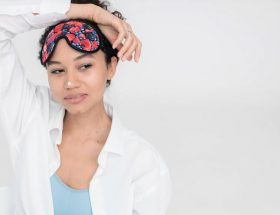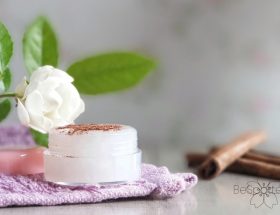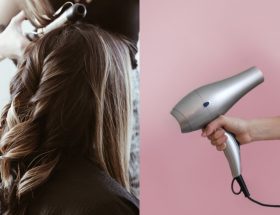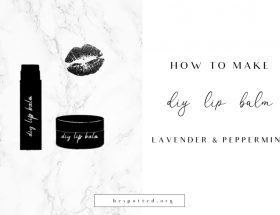This post may contain affiliate links. Any sales made through such links will reward me a small commission – at no extra cost for you!
Here’s how to use acne spot treatment to get the best results quickly…
I know first-hand how annoying acne can be. And how it can seem impossible to get rid of them. They followed me long after high school, making my life harder than it had to be. In retrospective, it was partially due to my own mistakes.
I am now finally acne free! (Well – almost, but who doesn’t get a hormonal zit or two every once in a while? I’ll take it – gratefully – any time, as long as I don’t have to deal with my skin from 3 years ago.)
I feel that cleansing my face with natural oils really helped the most. Although, I also had to pretty substantially change some of my life habits and the way I see skincare. And it was all sooo worth it!
But, for a long time, acne spot treatments were a regular part of my day-to day routine. I made a lot of mistakes with them before I figured out how to choose ones that can do the most for my skin. And before I learned how to use acne spot treatment properly.
To help you avoid those same mistakes, here’s a little guide that explains what is a spot treatment, what it should and shouldn’t do and when is the best time to apply it…
What Is A Spot Treatment?
Acne spot treatments are concentrated over-the-counter skincare products intended to quickly reduce individual acne. They are high in acne-fighting ingredients that can dry out the sebum, kill the bacteria, soothe the zit inflammation and help the skin to heal quicker.
Spot treatments work best if you only occasionally get a zit here and there. If your whole face is constantly breaking out and you’re overusing spot treatments, they could severely damage your skin in time.
For the same reason, you should never apply an acne spot treatment to your whole face, but only directly to an acne you want to treat. The same ingredients that work their magic on drying out acne could also dry out the rest of your face. Plus, most of these products are also irritating to the skin.
However, when used properly, spot treatments for acne are pretty powerful little things that can help you keep the things under control. But, properly is the key word here. Many people fail to get the best results simply because they are using acne spot treatments incorrectly. Or, to be more precise – they are using them at the wrong time.
More about that later. First, let’s see what to pay attention to when choosing an acne spot treatment and what active ingredients make them so great in getting rid of acne…
How to Choose a Spot Treatment for Acne
The very first thing you need to know about spot treatments is that stronger is definitely not always better. The product you choose should ideally be great in drying acne, but it should also be gentle enough so that it doesn’t disturb the healthy skin.
Try to find a spot treatment that, other than the acne fighting components, also contains skin soothing ingredients. Look for aloe vera, calamine, allantoin, licorice, green tea extract, etc.
As for the active anti-acne ingredients, the following 5 are the most common:
1. Benzoyl peroxide
Benzoyl peroxide is, no doubt, one of the best ingredients you can use to treat acne prone skin. Other than exfoliating the skin, it also releases oxygen into the pores and that way kills acne-causing bacteria. Plus, benzoyl peroxide is anti-inflammatory, so it can help soothe the inflamed red acne.
2. Salicylic acid
Salicylic acid is a beta hydroxy acid that is often used in skincare products to exfoliate the skin. It is oil-soluble, so it can pass through the sebum and all the way into your pores. Once there, it works to dissolve the plug, de-gunk the pore and dry out the acne.
3. AHAs
Alpha hydroxy acids are also often added to this type of products. Similarly to salicylic acid, AHAs exfoliate the skin, but they mostly stay on the surface. They cannot sink into the pores and unclog them the way salicylic acid does. But, they work great in synergy with other anti-acne ingredients.
4. Sulfur
Sulfur is another effective ingredient that can help you fight off blemishes and clear out your skin. It also has antibacterial, exfoliating and oil-absorbing properties. It is often referred to as a gentler alternative to benzoyl peroxide and salicylic acid. However, it shouldn’t be overused – sulfur still has a potential to irritate and dry out the skin.
5. Tea tree oil
Tea tree oil is one of the best natural solutions for acne. This essential oil has antibacterial and anti-inflammatory properties that can help with reducing acne and healing the skin. In fact, studies have proven that, although it takes longer to get the same results, tea tree oil can help reduce acne as effectively as benzoyl peroxide.
How to Use Acne Spot Treatment Properly
I used to be one of the people who apply a spot treatment on a pimple as soon as they notice even a slightest trace of it. This, of course, didn’t give the results I was hoping for, so I did a bit digging.
What I found more than surprised me. I actually ran into a Renée Rouleau‘s (a famous esthetician) advice. She said that acne spot treatments shouldn’t be applied at all while the acne develops, but only after you pop the acne!
Yup! It sounded crazy to me, too. But, I did try it her way, and it worked like a charm! So, bear with me – this ‘crazy’ theory actually makes a lot of sense once you know how your skin works and how acne forms.
How acne actually develops:
It all starts with a pore that gets blocked by dirt, dead skin cells, comedogenic products…
Now, the sebum that your skin produces should come out through that pore and moisturize the surface of your skin. But, since the pore is blocked, the sebum stays trapped in the skin, accumulating, mixing with the rest of the plug and eventually causing an infection.
Barely ever a pimple starts to develop right under the very surface of the skin. The inflammation and pus usually start to form much deeper, then slowly move its way up towards the skin’s surface. That is why you usually don’t see the yellow tip when the acne first starts to form; the pus is too deep down to be visible.
The pus moving up the pore is actually a skin’s natural process in which it is trying to get rid of the infection and to heal. That is why popping acne (when done properly, when the acne is ready to pop and only in pristine clean conditions) might actually be a good thing. It helps the skin to get rid of the pus faster.
So, what happens when you apply an acne spot treatment too early?
Well, spot treatments are designed to, amongst other things, dry out the acne. Which is great when you apply it directly to the pus.
But, if you apply it to the skin when the acne just started to form, acne spot treatment cannot reach deep enough into the skin to actually affect the pus. Instead, it dries out only the surface layer of the skin that is covering the acne deep under it.
And as if this isn’t bad enough, it actually gets worse. You see, when the spot treatment dries out (and irritates) that skin, what you get is lots of dead and flaky skin cells and an even thicker layer that is now covering your acne.
Now it is even harder for the pus to come out through that dry layer. So, it stays trapped for longer, which is why the recovery process is also prolonged.
So, applying a spot treatment to an acne that is still deep inside the skin doesn’t dry it out at all. It only makes it harder for the acne to heal naturally.
What to do instead:
In time, after some research and a lot of trying out and testing on my own skin, I developed a system that works best for me. It definitely enhances the way spot treatments work, helps me get rid of acne faster and speeds up the healing process (my acne marks, for example, fade much faster).
Here’s how I use acne spot treatment:
The moment I sense there’s a bump forming somewhere on my face, I start to apply a warm compress to it daily. The warmth softens up the oils in the pimple, opens up the pore and helps the pus to move towards the surface of the skin.
To apply a warm compress, all you have to do is soak a clean washcloth in hot water. The compress should be as hot as you can handle, without it burning your skin.
If I have the time, I try to do this for around 2 hours each day. For example, during watching a movie, and then a few more times, each around 10 minutes. But, you can also hold it for 10 – 15 minutes 4 – 5 times a day, or at least for 20 minutes every morning and night.
During these days, I don’t apply any special products to the affected area. I just try to keep it generally clean.
Usually, after 2 – 3 days, the pimple is ready for extraction. When I can see most of the pus right under the surface of the skin (a clearly visible white or yellowish tip), I try to gently squeeze it out. (If it’s not coming out after a few squeezes, I just leave it alone until the next day.)
Once I’ve extracted most of the pus, I apply a small amount! of my spot treatment, to dry out what’s left in the pore. Applied like this, the spot treatment reduces the inflammation, stops the infection and speeds up the healing process.
I keep applying the treatment twice a day until the acne is all gone. It usually doesn’t take long before I can’t see even traces of the pimple that would normally linger around for ages.
Common Mistakes When Using an Acne Spot Treatment
There’s a couple more things you should keep in mind in order to get the best results out of your product. And avoiding some common mistakes can go a long way. Not only it can help the acne heal faster, but it will also protect the rest of your skin from the harsh, drying effect.
We’ve already talked about how counterproductive it can be to start with a spot treatment too soon. Other than that, there are a few more things to avoid, so let’s just quickly go through them:
1. Applying acne spot treatment to a whole face
Spot treatments cannot prevent new acne from occurring. They only treat the already developed individual acne. Applying a spot treatment to your whole face not only won’t prevent breakouts, but it can severely dry out and irritate your healthy skin.
2. Layering it in a wrong order
Acne treatment should only be applied to a clean skin, never before cleansing. Also, if you apply a spot treatment to your acne, then a moisturizer over it, the moisturizer will smear the spot treatment, distributing it all over your face.
So, you can either apply your acne treatment, then try to go around it and avoid the area as much as possible when applying the following products. Or, you can complete your routine as usual, then wipe the blemished area with a damp tissue or cotton ball, to remove the moisturizer. Then just apply your acne spot treatment to the acne and let it dry.
3. Using too harsh products
Spot treatments are concentrated, powerful products by default. Though they vary in strength, barely anyone needs a full-power acne treatment.
For example, you can find OTC products with benzoyl peroxide in concentrations of 2.5 – 10%. However, most experts agree that 5% or 10% benzoyl peroxide is not actually more effective than 2.5%.
Salicylic acid, also, is available in OTC products in concentrations of 0.5 – 5%. But, it is always best to start slowly with your acids, then gradually increase the percentage until you are happy with the results.



















